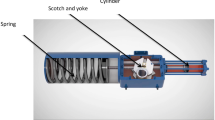Abstract
In an HLA (hydraulic lash adjuster) piston engine, “pump up” can occur when a valve is opened by the HLA when it should be closed. HLA pump up is more frequently encountered with exhaust valves than with intake valves. When HLA pump up in occurs in the exhaust valve, exhaust gas from the exhaust manifold enters the cylinder on the intake stroke, and fresh air-fuel mixture exits through the exhaust manifold on the compression stroke and is burned in the catalyst, causing partial burning, misfire, catalyst melting and power drop. HLA pump up occurs when the force on the valve from the HLA is higher than the force on the HLA from the valve. HLA pump up is related to design parameters, such as oil pressure, rocker ratio, spring load, spring surge, and both intake and exhaust valve timing. In this study, valve lift and load on a roller finger follower were measured at varying engine firing conditions to evaluate HLA pump up. The results indicated that effective measures to reduce HLA pump up include a higher rocker ratio, a lower oil supply pressure to the HLA, a higher spring installation load and a lower spring surge.
Similar content being viewed by others
References
Bota, J., Kumagai, T., Fujimura, T., Takayama, S. and Hatamura, K. (2009). Comparison of MBD simulation with measurements for roller-finger-follower with HLA valve train system behavior in higher engine speed. Conf. JSAE, JSAE 20095248.
Choi, M. S., Han, K. B., Kim, H. I., Oh, D. Y. and W. T. Kim (2007). Mechanical parameters for durability and HLA pump up in Tau engine. Conf. Hyundai-Kia Motors EN. 01-07, 2007EN0108.
Heywood, J. B. (1988). Internal Combustion Engine Fundamentals. McGraw-Hill Int. Edn. 737–739.
Koshimizu, T., Kikuoka, S., Hibino, Y., Otsubo, M. and Ishikawa, S. (2004). Development of high response hydraulic lash adjuster. Conf. JSAE, JSAE 20045667.
Lee, S. and Kim, W. (2008?). Development of a new high performance 4.6 liter V-8 HMC Tau engine. FISITA 2008, F2008-06-085.
Otsubo, M., Saito, T. and Hibino, Y. (2004). Analysis method for high-speed performance of valve train with HLA. Conf. JSAE, JSAE 20045615.
Schwarz, D., Bach, M. and Fuoss, K. (2009). Valvetrain investigation on fired engines. Porsche Engineering Services, MTZ 06I2009, 70, 36–41.
Author information
Authors and Affiliations
Corresponding author
Rights and permissions
About this article
Cite this article
Choi, M., Min, K. Influential factors for HLA pump up in a roller finger follower engine. Int.J Automot. Technol. 12, 469–474 (2011). https://doi.org/10.1007/s12239-011-0055-3
Received:
Revised:
Published:
Issue Date:
DOI: https://doi.org/10.1007/s12239-011-0055-3




